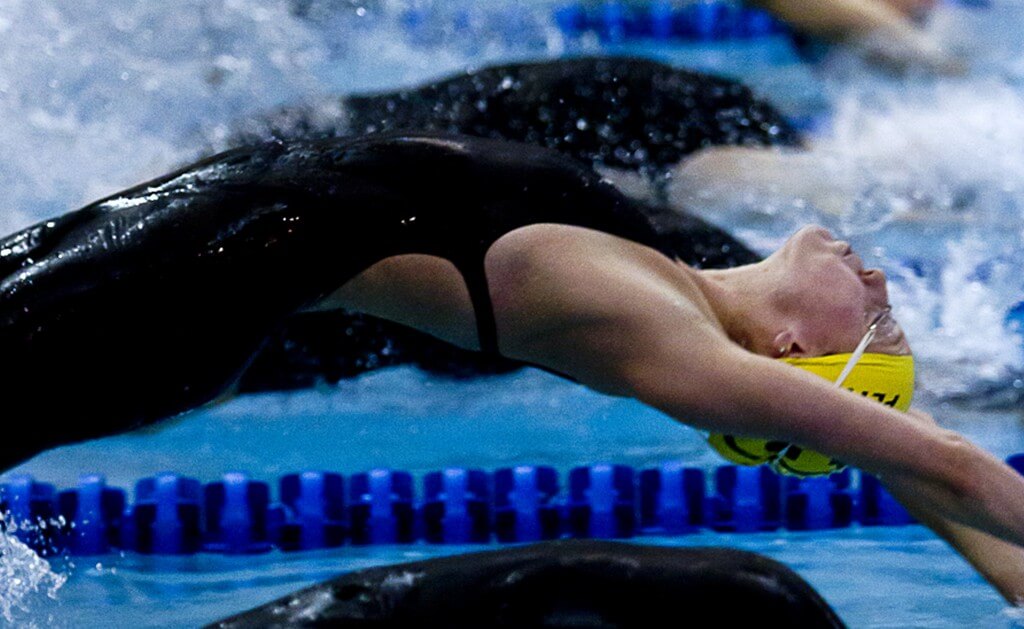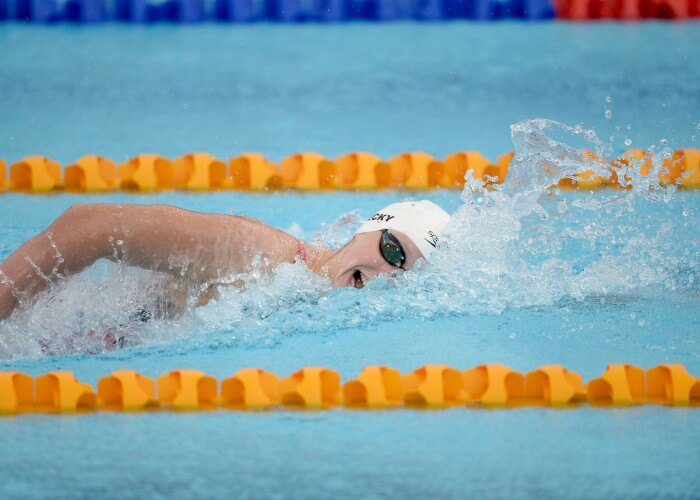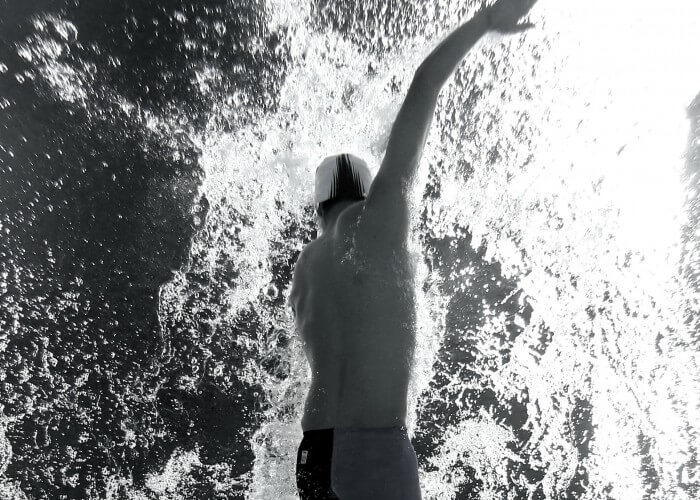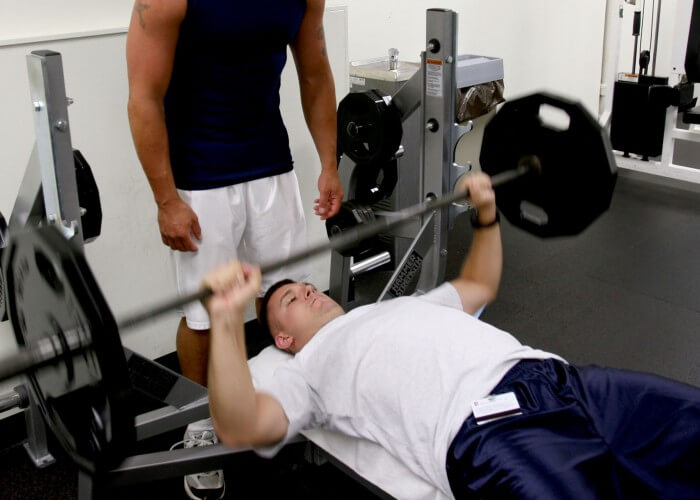Dryland Workouts for College Swimmers and Sprint Training Effectiveness Examined in Scientific Research

Photo by Kyle Staggs
By Dr. G. John Mullen
This post is a review of the most recent research pertinent to swimmers. If you like these reviews, consider purchasing the Swimming Science Research Review. The Swimming Science Research Review is a monthly review of all the sports science literature pertinent to swimming. Order your copy today!
Two Weeks of HIT Increases Performance and Power Output
After the 2 weeks of high-intensity training (HIT) triathlon training, youth athletes improved peak power and performance. There were no significant changes in peak oxygen uptake, but increases in body weight. Cortisol (stress hormone) was unchanged throughout the study. Growth hormone significantly increased from baseline levels. Triiodothyronine did not change during training. Testosterone significantly increased after 2 weeks. Overall, it seems two weeks of HIT enhances performance in youth triathletes. Although this training is far from traditional swimming workouts, it seems HIT does enhance performance for this group and swimmers and coaches should consider high-intensity training, if they don’t already incorporate it. Read more on HIT, HIIT, and USRPT.
Stroke Index and Performance
Swimming economy and mechanical pattern can be expressed by a stroke index (SI). SI is the result of an optimal combination of stroke rate (SR) and stroke length (SL). It is not well-understood how anthropometric measures that change, with childhood growth and development, affect swimming performance. Mezzaroba (2014) timed and counted strokes in adolescent swimmers. Some quick calculations: stroke rate (SR) = C/T (cycles/s), stroke length (SL) = S/SR (m/cycle), and stroke index (SI) = SL/S.
SI itself could explain 90% of performance variation in 10-17 year old swimmers. Height, limb length, and advancing age appear to be strongly related to the ability to make technical adjustments for different competitive distances, maintaining optimal speeds. Young swimmers significantly reduce SR with increasing distance but were not totally effective in offsetting this adaptation with increased SL, especially from 200 to 400M distances. This highlights the decreased efficiency with significant SI reduction in younger swimmers inability to modify SL from 100 to 400m until ~14years of age.
Coaches should consider technical parameters in the initial training ages:
- Monitoring SL and SR throughout competitive distances
- Aware of differences in growth rates and maturity on technical skills
- Utilize SI to monitor and control training (training groups) technical skills vs. swimming performance
Fluid Forces During Sculling
Although sculling is far from swimming, some still believe sculling occurs during swimming strokes and is implemented as a drill by many swimmers. Takagi (2014) had swimmers perform a stationary sculling motion while using a new technology, particle image velocimerty. This method is used to visualize flow and measuring instantaneous velocities and related properties in fluids. Once again, this is far from a swimming study, but the results demonstrate skilled swimmers produce large unsteady fluid forces during sculling. Although many coaches already know elite swimmers create large unsteady fluid forces, this research confirms the lack of stability of particles in the unique equilibrium of water.
Collegiate Freshmen are not Ready for College Strength and Conditioning
Although many questions remain about strength and conditioning and swimming enhancement, nearly all colleges utilize strength training. Unfortunately, many swimmers are not prepared for a college strength and conditioning program when they first arrive on campus, the main reason why about 50 percent of swimming injuries occur during dryland routines (Wolf 2009). Wade (2014) surveyed college strength and conditioning coaches, and asked “How prepared are college freshmen athletes for the rigors of college strength and conditioning?”
The results:
“Strength and conditioning coaches stated that incoming college freshman athletes lack lower extremity strength, overall flexibility, and core strength as well as proper Olympic lifting technique. Strength and conditioning coaches also stated that athletes lacked the mental toughness to endure collegiate sport training in addition to claiming incoming athletes lacked knowledge of correct nutrition and recovery principles. These results suggest a lack of collegiate training/sport preparedness of high school athletes (Wade 2014).”
It seems the college strength and conditioning programs were quite harsh on college athletes. No matter if you think strength training benefits swimming or not, if you are a club coach, preparing your athletes for the rigor of college is essential. Too often clubs neglect dryland, having the coaches perform these duties themselves. This doesn’t sound bad if you have a proactive coach, studying biomechanics and proper form, but this is rarely the case. If you are working with high school-aged swimmers on the verge of swimming in college, providing a safe, effective, purposeful strength training program will help them acclimate to college swimming, reducing the stress of college swimming in freshman year and reduce injuries. Unless you are a swimming coach with a background in strength and conditioning (ie you have a certification), you should not be providing this service. This may sound harsh, but would you trust a strength coach providing swim workouts? If you are on a budget, reach out to your parents, see if any of them have a background in strength and conditioning or take a course/read a book on proper form/principles. If your club can afford it, hire someone to come in and monitor/teach form or hire a consultant, for the short-term and long-term safety of the swimmers.
Breast Displacement During Swimming
Few in the swimming community are comfortable discussing the topic of breast displacement during swimming although it greatly influences swimming biomechanics. Also, if you talked or have worked with female swimmers, you’d likely agree the trunk and breast can influence swimming biomechanics and velocity. Mills (2014) performed a biomechanical analysis on breast displacement in recreational swimmers. The research suggests current swim suit design is not effective in minimizing breast displacement.The researchers also noted greater breast displacement occurred in freestyle compared to breaststroke. Once again, this was not done in elite swimmers, but more research on elite swimmers and more advanced swimwear (ie high-tech suits) will help suit manufactures optimize swim suits for women with varying breast size.
References:
- Zinner C, Wahl P, Achtzehn S, Reed JL, Mester J. Acute hormonal responses before and after 2 weeks of HIT in well trained junior triathletes. Int J Sports Med. 2014 Apr;35(4):316-22. doi: 10.1055/s-0033-1353141. Epub 2013 Sep 30.
- Takagi H, Shimada S, Miwa T, Kudo S, Sanders R, Matsuuchi K. Unsteady hydrodynamic forces acting on a hand and its flow field during sculling motion. Hum Mov Sci. 2014 Oct 10;38C:133-142. doi: 10.1016/j.humov.2014.09.003. [Epub ahead of print]
- Wolf BR, Ebinger AE, Lawler MP, Britton CL.Injury patterns in Division I collegiate swimming. Am J Sports Med. 2009 Oct;37(10):2037-42. Epub 2009 Jul 24.
- Wade SM, Pope ZC, Simonson SR. How prepared are college freshmen athletes for the rigors of college strength andconditioning? A survey of college strength and conditioning coaches. J Strength Cond Res. 2014 Oct;28(10):2746-53. doi: 10.1519/JSC.0000000000000473.
- Mills C, Lomax M, Ayres B, Scurr J. The movement of the trunk and breast during front crawl and breaststroke swimming. J Sports Sci. 2014 Sep 5:1-10. [Epub ahead of print]
- Mezzaroba PV, Machado FA. Effect of age, anthropometry, and distance in stroke parameters of young swimmers. Int J Sports Physiol Perform. 2014 Jul;9(4):702-6. doi: 10.1123/ijspp.2013-0278. Epub 2013 Nov 14. PubMed PMID: 24231272.






